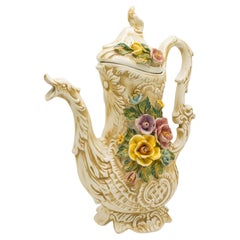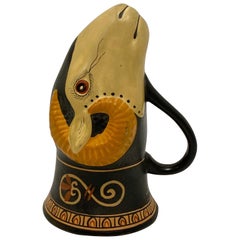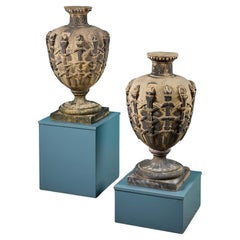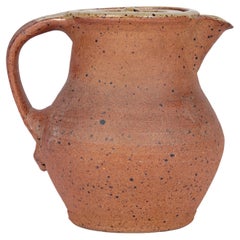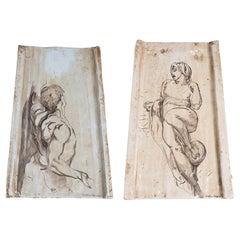Italian Ceramics
8
1
1
to
2
8
2
10
10
10
665
281
56
27
27
22
10
8
6
4
3
1
5
3
2
1
2
1
10
6
4
2
1
74
34
33
10
10
2
1
Style: Neoclassical
Place of Origin: Italian
Ancient Pair Coffee Pots, Pasquale Rubati Manufacture Milan, 1770 circa
By Pasquale Rubati
Located in Milano, IT
Pair of small coffee pots.
Manufacture of Pasquale Rubati
Milan, 1770 Circa
Maiolica polychrome decorated “a piccolo fuoco” (third fire).
a) height 7.87 x 5.51 x 3.93 in (20 x 14 x ...
Category
1760s Neoclassical Antique Italian Ceramics
Materials
Maiolica
Antique Floral Encrusted Ewer, Italian, Decorative, Wine Pouring Jug, Circa 1920
Located in Hele, Devon, GB
This is an antique floral encrusted ewer. An Italian, ceramic decorative pouring jug, dating to the early 20th century, circa 1920.
Striking Italian ewer...
Category
1920s Neoclassical Vintage Italian Ceramics
Materials
Ceramic
Italian Neo-Classical Grand Tour Style Ram’s Head Stirrup Cup
Located in Kennesaw, GA
This is an Italian neo-classical Grand Tour ram’s head form stirrup cup. The composition is pottery with an almost bisque-like finish.
Category
Mid-20th Century Neoclassical Italian Ceramics
Materials
Pottery
Light Blue and Gray Ceramic Majolica Amphora Hand Painted Francois Boucher Italy
Located in Recanati, IT
Large ceramic amphora with handles, made and painted entirely by hand, central Italy production, year 2009. The decoration on the vase is a reproduction of a painting by Francois Bou...
Category
Early 2000s Neoclassical Italian Ceramics
Materials
Ceramic, Majolica
Two Pairs of Italian Maiolica Baskets, circa 1780
By Antonio Ferretti
Located in Milano, IT
Two pairs of maiolica baskets
Antonio Ferretti Manufacture
Lodi, circa 1770-1790
Maiolica polychrome decorated “a piccolo fuoco” (third fire).
Measures: A) Height 3.54 x 6.69 x 9.84 in (9 x 17 x 25 cm);
B) Height 3.93 x 7.48 x 11.02 in (10 x 19 x 28 cm).
Total weight 4.85 lb (2.200 kg)
State of conservation:
A) One of the smaller baskets has some areas of restoration, the other slight chipping from use;
B) One of the larger baskets is intact and the other shows a clearly glued break.
The mold with which the baskets were forged simulates a wicker weave.
The two larger works have high, vertical walls, with branch-shaped handles penetrating the weave. The painted decorations, small polychrome flowers applied only externally, highlight the points where the weaves intersect.
The decision to leave the center of the basket devoid of decoration is highly unusual, but given the size and complexity of the shape, as well as the quality of the enamel, it is possible to hypothesize that it represents a precise choice in manufacturing or for a particular client.
The two smaller baskets have small, twisted handles and, on the outside, reproduce more decisively the characteristic wicker weave, obtained through thin molded lines. The interior exhibits a rich, typical decoration of naturalistic flowers: a bunch centered around a main flower and secondary stems accompanied by small “semis”. The exterior of these works is also adorned with small little flowers where the weaves intersect.
The size and morphological characteristics of the baskets confirm their attribution to the Lodi factory of Antonio Ferretti between 1770 and 1790, during its most successful period; by this point his original reworking of the "Strasbourg" decoration, known as "old Lodi", had achieved great fame even outside Italy.
This decorative choice represented a strong point of the Lodi factory, which established itself thanks to the vivid nature of the colors made possible by the introduction of a new technique perfected by Paul Hannong in Strasbourg and which Antonio Ferretti introduced in Italy. This production process, called “piccolo fuoco” (third fire), allowed the use of a greater number of colors than in the past; in particular, the purple of Cassius, a red made from gold chloride, was introduced. Its use allowed for many more tones and shades, from pink to purple.
The Ferretti family had started their maiolica manufacturing business in Lodi in 1725.
The forefather Simpliciano had started the business by purchasing an ancient furnace in 1725 and, indeed, we have evidence of the full activity of the furnaces from April of the same year (Novasconi-Ferrari-Corvi, 1964, p. 26 n. 4). Simpliciano had started a production of excellence also thanks to the ownership of clay quarries in Stradella, not far from Pavia. The production was so successful that in 1726 a decree of the Turin Chamber came to prohibit the importation of foreign ceramics, especially from Lodi, to protect internal production (G. Lise, La ceramica a Lodi, Lodi 1981, p. 59).
In its initial stages, the manufacture produced maolicas painted with the “a gran fuoco” (double fire) technique, often in turquoise monochrome, with ornamentation derived from compositional modules in vogue in Rouen in France. This was also thanks to the collaboration of painters like Giorgio Giacinto Rossetti, who placed his name on the best specimens next to the initials of the factory.
In 1748 Simpliciano made his will (Gelmini, 1995, p. 30) appointing his son Giuseppe Antonio (known as Antonio) as universal heir. After 1750, when Simpliciano passed away, Antonio was directly involved in the maiolica factory, increasing its fortunes and achieving a reputation on a European level. Particularly important was the aforementioned introduction in 1760 of the innovative “a piccolo fuoco” (third fire) processing, which, expanding the ornamental repertoire with Saxon-inspired floral themes, could commercially compete with the German porcelains that had one of its most renowned offerings in the naturalistic Deutsche Blumen. Antonio Ferretti understood and promoted this technique and this decoration, proposing it in a fresher and more corrective version, less linked to botanical tables...
Category
1770s Neoclassical Antique Italian Ceramics
Materials
Maiolica
Italian Neoclassical White Glazed Ceramic Urn, Large Scale
By Ceccarelli
Located in Stamford, CT
This classic Tuscan vase is a refined decorative complement to both traditional and contemporary interiors. Handcrafted of ceramic and glazed white it feat...
Category
Mid-20th Century Neoclassical Italian Ceramics
Materials
Ceramic
Pair of Deep Red Glaze and 24ct Gold Leaves Majolica Vases, Italy, 21st Century
Located in London, GB
Pair of vases by Antonietta Mazzotti Emaldi, 2018, Glazed earthenware (majolica) and 24ct gold, entirely handmade, unique pieces.
Antonietta Mazzotti (Faenza, Italy 1950) attended the Istituto d’Arte per la Ceramica in Faenza and opened her first workshop in her hometown taking part in group and solo exhibitions at international level. In 1976 she has transformed the neo-gothic greenhouse of Villa Emaldi in her workshop. Antonietta Mazzotti has worked for some of the most important international museums and has received several important recognitions worldwide. Her works have been featured in major Italian magazines of interior design and she has acquired international visibility being featured in major international press publications, such as The New York Times. She still lives and works at Villa Emaldi in Faenza where she continues her research on historical decor...
Category
21st Century and Contemporary Neoclassical Italian Ceramics
Materials
Gold
Italian Maiolica Pharmacy Flasks Felice Clerici, Milan Circa 1770-1780
By Felice Clerici
Located in Milano, IT
Two maiolica pharmacy flasks
Milan, Felice Clerici Manufacture, 1770-1780
They each measure 9.44 in (24 cm) in height x 6.10 in (15.5 cm) in diameter
lb 4 (kg 1.8)
State of conserva...
Category
1770s Neoclassical Antique Italian Ceramics
Materials
Maiolica
Ceramic Drug Jar or Syrup Jar, Possibly Italy, 18th Century
Located in Madrid, ES
The decoration of ceramics in blue tones on a white background was common in Europe as far back as the 17th century (Dutch and English pieces, works in Talavera de la Reina in Spain,...
Category
18th Century Neoclassical Antique Italian Ceramics
Materials
Ceramic
Four Italian Ancient Dishes, Lodi, circa 1770-1780
By Antonio Ferretti
Located in Milano, IT
Assortment of 4 dishes with braided rim
Antonio Ferretti Manufacture
Lodi, circa 1770-1780
Maiolica polychrome decorated “a piccolo fuoco” (third fire).
Measures: 14 x 10 in (35.5 x 25.5 cm);
12.2 x 8.39 in (31 x 21.3 cm);
10.4 x 9.65 in (26.5 x 24.5 cm);
10.8 x 9.61 in (27.5 x 24.4 cm).
Weight: 4.4 lb (1.998 kg)
State of conservation: some chips due to use on the edges and on the parts in relief.
The four different dishes have a foot with a low lip from which extends a wide, flat, slanted rim resembling a basket weave. The small handles are painted green: they resemble wickerwork in the two oval dishes and take the form of a sinuous branch in the round ones.
The third fire decoration is inspired by the naturalistic floral botanical patterns on the ceramics produced by the Hannong family in Strasbourg. Here the pattern is defined by the rapidity and subtlety of the brushstrokes and the result is particularly tasteful, characterized by compositional intelligence and pictorial expertise.
A main corolla, either a wild or garden rose, is set slightly off center in each well. From this extends a thin stem holding a small secondary bud and there are small field florets dotting the composition to lend volume to the delicate bunch of flowers.
On the brim, small polychrome flowers add color to the weave, accompanied by lanceolate leaves of a very intense green.
There exist few and very rare examples for comparison with this morphology: a round plate - entirely consistent with those in question - has been dated to around 1775 (S. Levy, Maioliche settecentesche lombarde e venete, Milano 1962, tav. 200). Two other dishes with a basket rim, but with parallel striped brim decoration, were exhibited in the 1995 exhibition on Lodi ceramics; the attribution to the Lombard town near Milan is therefore almost exclusively derived from the decoration called "alla rosa contornata" or "alla vecchia Lodi" and constitutes one of the most popular decorations during the eighteenth century. (M. L. Gelmini, in Maioliche lodigiane del '700 (cat. mostra Lodi), Milano 1995, pp. 31 p. 162-163 nn. 181-182).
This decorative choice represented a strong point of the Lodi factory, which established itself thanks to the vivid nature of the colors made possible by the introduction of a new technique perfected by Paul Hannong in Strasbourg and which Antonio Ferretti introduced in Italy. This production process, called “piccolo fuoco” (third fire), allowed the use of a greater number of colors than in the past; in particular, the purple of Cassius, a red made from gold chloride, was introduced. Its use allowed for many more tones and shades, from pink to purple.
The Ferretti family had started their Maiolica manufacturing business in Lodi in 1725.
The forefather Simpliciano had started the business by purchasing an ancient furnace in 1725 and, indeed, we have evidence of the full activity of the furnaces from April of the same year (Novasconi-Ferrari-Corvi, 1964, p. 26 n. 4). Simpliciano had started a production of excellence also thanks to the ownership of clay quarries in Stradella, not far from Pavia. The production was so successful that in 1726 a decree of the Turin Chamber came to prohibit the importation of foreign ceramics, especially from Lodi, to protect internal production (G. Lise, La ceramica a Lodi, Lodi 1981, p. 59).
In its initial stages, the manufacture produced maolicas painted with the “a gran fuoco” (double fire) technique, often in turquoise monochrome, with ornamentation derived from compositional modules in vogue in Rouen in France. This was also thanks to the collaboration of painters like Giorgio Giacinto Rossetti, who placed his name on the best specimens next to the initials of the factory.
In 1748 Simpliciano made his will (Gelmini, 1995, p. 30) appointing his son Giuseppe Antonio (known as Antonio) as universal heir. After 1750, when Simpliciano passed away, Antonio was directly involved in the Maiolica factory, increasing its fortunes and achieving a reputation on a European level. Particularly important was the aforementioned introduction in 1760 of the innovative “a piccolo fuoco” (third fire) processing, which, expanding the ornamental repertoire with Saxon-inspired floral themes, could commercially compete with the German porcelains that had one of its most renowned offerings in the naturalistic Deutsche Blumen. Antonio Ferretti understood and promoted this technique and this decoration, proposing it in a fresher and more corrective version, less linked to botanical tables...
Category
1770s Neoclassical Antique Italian Ceramics
Materials
Maiolica
Related Items
Pair of Neoclassical Style Antique Sandstone Garden Urns
Located in Wormelow, Herefordshire
This spectacular pair of neoclassical style antique sandstone garden urns were sourced from an estate in the west of Scotland circa 1800. Both decorative stone urns are of a large an...
Category
Late 18th Century Neoclassical Antique Italian Ceramics
Materials
Sandstone
Bernard Leach Midcentury Studio Pottery Ash Glazed Coffee Pot
By Bernard Leach
Located in Bishop's Stortford, Hertfordshire
A stylish midcentury ash glazed handcrafted Studio Pottery coffee pot by renowned English potter Bernard Leach CBE (British, 1887-1979) and made at ...
Category
20th Century Mid-Century Modern Italian Ceramics
Materials
Stoneware
Guido Gambone Ceramic Decorative Cup Vide-Poches or wall decoration 1950's
By Guido Gambone
Located in Paris, FR
Guido Gambone (1909-1969)
Hand enameled geometric decor on grey glazed ceramic.
Can be used as vide-poche or wall decor
Signed Gambone, Italy with donkey mark. Nice condition
Guido G...
Category
Mid-20th Century Italian Ceramics
Materials
Ceramic
Free Shipping
H 0.79 in W 6.3 in D 7.88 in
19th Century Neoclassical Bronze Dore Urn Signed F. Levillain
By Ferdinand Levillain
Located in Savannah, GA
19th century neoclassical signed bronze doré urn with handles and adorned with elaborate roman scenes. Signed stamped F. Levillain. Ferdinand Levillain...
Category
19th Century Neoclassical Antique Italian Ceramics
Materials
Bronze
Studio Pottery Weed Pot, circa 1975
Located in Costa Mesa, CA
Studio Pottery weed pot / vase. circa 1975.
Category
20th Century Mid-Century Modern Italian Ceramics
Materials
Ceramic
Pair of Large Neoclassical Urns
Located in New York, NY
Pair of large neoclassical urns. Grand tour patinated copper craters after the antique with swan-form handles from Naples. Italy, early 19th century.
Dimension: 24.5" H x 15" D X 1...
Category
Early 19th Century Grand Tour Antique Italian Ceramics
Materials
Copper
Pair of Large Italian Urns
Located in Hudson, NY
Stamp says: Arte Italica, Made in Italy.
Category
20th Century Italian Ceramics
Materials
Ceramic
Glazed Terracotta Antique Urn
Located in Austin, TX
A 19th century antique glazed terra cotta urn from Biot, France. We love the character and patina on this beautiful and impressive jardinière.
Category
1880s Antique Italian Ceramics
Materials
Terracotta
Wedgwood Jasperware Blue and White Jewelry Dish Neoclassical Style, Late 19th c
By Wedgewood
Located in New York, NY
An antique Wedgwood Jasperware blue and white oblong jewelry dish in the Neoclassical Style, circa late-19th century, England. Piece has a ...
Category
Late 19th Century Neoclassical Antique Italian Ceramics
Materials
Stoneware
H 0.63 in W 5.88 in D 2.32 in
Large Neoclassical Style Painted Cast Iron Garden Urn
Located in Rio Vista, CA
Heavy and large painted cast iron garden urn or jardinaire constructed in the neoclassical taste. The grand urn features applied acanthus scrolled handles on each side of the body. T...
Category
20th Century Neoclassical Italian Ceramics
Materials
Iron
Vintage Round Italian Colorful Hand Painted Ceramic Majolica Fruit Platter
Located in Oklahoma City, OK
A colorful jewel toned polychrome majolica platter decorated with various embossed fruits such as peaches, grapes, tomatoes, pears and various green foliage. It has been hand painted...
Category
20th Century Renaissance Italian Ceramics
Materials
Ceramic, Paint
Louis Guarnieri Buffalo NY Advertising Wine Jug, circa 1880-1920
Located in San Diego, CA
Late 19th century, modeled in stoneware (wine jug), flanked by double handles, the top glazed deep brown, stamped "Louis Guarnieri 389 Swan Street, Buffalo, N.Y"., circa 1880-1920. This is a very nice early Stoneware Advertising Jug...
Category
19th Century American Classical Antique Italian Ceramics
Materials
Ceramic
Previously Available Items
Pair of Italian Painted Tiles
Located in Alessandria, Piemonte
These two tiles were painted by Giampiero Mancinelli for the famous De Ruta in 1996.
One (nr. 2025) from Rubens: "Male nude seen partially from behind". Base...
Category
Late 20th Century Neoclassical Italian Ceramics
Materials
Ceramic
Virgin Mary, Lencci 'Madonna'
Located in Buenos Aires, Argentina
Virgin Mary, Lencci (Madonna)
Origin Torino, Italy
design Helen Scavini
circa 1940.
Category
1930s Neoclassical Vintage Italian Ceramics
Materials
Ceramic
Set of Three Unique Pieces Hand Painted Paladin Sicilian Albarello Vases
Located in Aci Castello, IT
Three hand painted terracotta vases made in Caltagirone, world famous Sicily town for ceramics. Originally they are used for medical herbs, they are unique pieces expressly made for ...
Category
2010s Neoclassical Italian Ceramics
Materials
Terracotta
Large Neoclassical Terracotta Vase Hand Decorated by Tellatin, Nove
By Nove di Bassano
Located in Vigonza, Padua
Antique 1848 signed large neoclassical terracotta vase hand decorated by Tellatin, Nove di Bassano, mid-20th century
Large amphora from 1848 w...
Category
Mid-19th Century Neoclassical Antique Italian Ceramics
Materials
Terracotta
Set of Three Unique Pieces Hand Painted Sicilian Terracotta Albarello Vases
Located in Aci Castello, IT
Three traditional pharmacy vases totally handcrafted and painted with sea decor. They are unique pieces especially made for our shop.
Category
2010s Neoclassical Italian Ceramics
Materials
Terracotta
20th Century, Italian Ceramic Centerpiece Bowl in Neoclassical Style
Located in IT
20th century, Italian ceramic centerpiece bowl in neoclassical style
This bowl, in neoclassical style, is made in Italy, in the early ye...
Category
Early 20th Century Neoclassical Italian Ceramics
Materials
Ceramic
Set of Three Unique Pieces Hand Painted Sicilian Terracotta Albarello Vases
Located in Aci Castello, IT
Three totally handcrafted Sicilian vases, they are hand painted unique pieces made especially for our shop. In the two sides are painted French Paladins.
Category
2010s Neoclassical Italian Ceramics
Materials
Terracotta
Blue and White Neoclassical Lion Mask Cachepot Tureen
By Del Vecchio Napoli 1
Located in New York, NY
Blue and white neoclassical lion mask cachepot tureen. Italian creamware zuppiera soup tureen with pale blue banding, of tripod form with three lion masks terminating in lion-claw monopedia on stepped circular plinth base. Impressed marks for Del Vecchio...
Category
Early 19th Century Neoclassical Antique Italian Ceramics
Materials
Creamware
Pair of Black Basalt Mottahedeh Figures from Classical Antiquity
By Mottahedeh
Located in Hanover, MA
Mottahedeh basalt ceramic classical figures of Jupiter and Minerva, both bearing shields with the head of Medusa.
Ceramic with black basalt finish and gilt glazed base. Both figur...
Category
1960s Neoclassical Vintage Italian Ceramics
Materials
Ceramic
Eight 1950s Piero Fornasetti Musicalia Canapes or Coasters
By Fornasetti
Located in Miami, FL
.Elegant and pure Fornasetti, these eight gilt, black and white dishes featuring neoclassical visions of musical instruments were an exclusive b...
Category
1950s Neoclassical Vintage Italian Ceramics
Materials
Ceramic
Naples Giustiniani Etruscan Dish
By Giustiniani Family 1
Located in Katonah, NY
A Giustiniani redware Greek Revival dish decorated in the Etruscan style after the antique. With classical figures painted in black and red on a terracotta ground all within a geomet...
Category
1840s Neoclassical Antique Italian Ceramics
Materials
Terracotta
Pair of Italian, White Ceramic Urn Vases
Located in Rome, IT
A pair of Italian white ceramic urn vases, manufactory of bassano del grappa. Early 20th century.
44 X 21 cm.
44 X 21 cm.
Category
20th Century Neoclassical Italian Ceramics
Recently Viewed
View AllMore Ways To Browse
Staffordshire Church
Wooden Mug
Delftware Bowl
Ceramic Sets Vietri
Masons Ironstone Imari Plate
Chinese Export Canton Blue White Plate
Antique Glass Swan Dish
Wedgwood Green Leaf Plate
Ceramic Candy Dish
Faux Bois Ceramic Vallauris
Famille Rose Teapot
Cigarette Case 1960s
Jardiniere Pattern Ironstone
Jean Cocteau Dish
Large Rose Medallion Bowl
Larson Pottery
Morten Lobner Espersen
Morten Lobner
